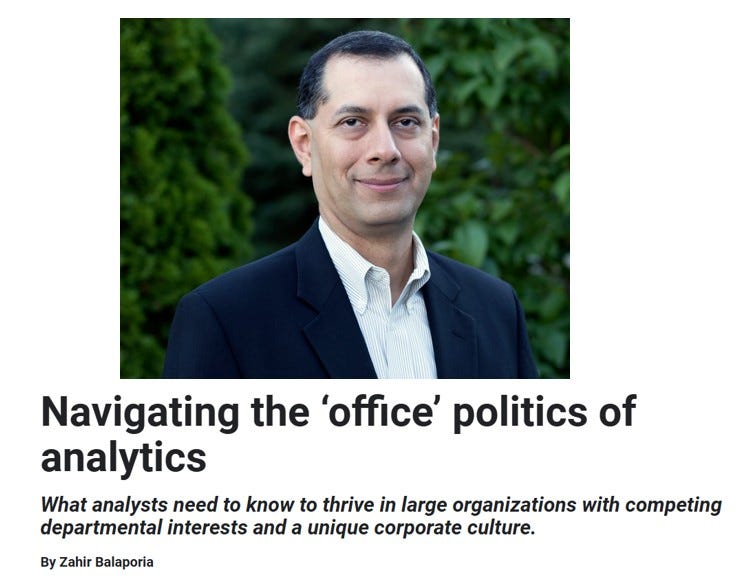Insights from Zahir Balaporia: Politics, The Extra Mile, Communicating, and Reorgs
Thanks to Zahir Balaporia for being a guest on our podcast. We discussed his article, Navigating the ‘office’ politics of analytics. The conversation touched on many interesting points. (Here are the links on Spotify, Apple, and YouTube.)
Here are some of my favorite takeaways.
Politics shouldn’t be assumed to be negative. It is just a word to describe the art of reaching compromises.
We often think of politics in a negative light. Zahir described its essence as negotiating through various organizations to reach a conclusion.
Going the “extra mile” helps.
To make complicated analytics projects stick, you often need to do more than just deliver a great solution. Zahir shared a story about how he helped build his credibility with truck drivers by riding with them and assisting with a minor issue.
This is the short- and long-game of politics. In the short game, you aim to win each specific instance. Unless you are exceptionally skilled, this is likely to be a poor strategy. Instead, the long game is to build trust by going the extra mile. This credibility will help later on, especially with complex solutions.
Know the key point of your presentation.
Zahir helped me out with a story. One of the things I try to impress on my students is the importance of getting to their main point quickly and concisely.
Zahir mentioned an executive meeting where he had planned on a 30-minute presentation. When he arrived, the executive was on a call and said that it would just be a minute. Well, ten minutes later, the executive was still talking.
This will happen to all of us in our careers. This is why it is so important to understand the main point and be able to reach it quickly.
Create user interfaces that your users can relate to
Zahir made a point similar to one made by Doug Gray: If possible, replicate what users are accustomed to seeing. This will help you with change management and adoption.
New decision intelligence systems may require a new organizational structure.
The benefits of a new decision intelligence system often come from making decisions across organizations. When this happens, the organizations may have to change.
For example, Zahir mentioned a dispatching system that had been broken into different functions. The optimization system looked at it simultaneously. This meant that the old roles of dispatcher for each function were no longer needed. It took ~10 months to implement the change management process to effect this change.
There are many more insights in the full interview.




